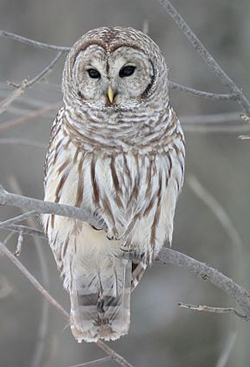Information About The Bird
Seen/Heard at
Decorah, Decorah North
Diet
Barred Owls are non-migratory and live in the Decorah area year-round. They eat small animals, including squirrels, chipmunks, mice, voles, rabbits, birds, amphibians, reptiles, and invertebrates. If you read Guardians of Ga’Hoole, you might remember the fishing owl! Barred Owls will dive for fish and wade into shallow water to catch fish and crayfish. Like eagles and falcons, they cache prey for eating later on. Cornell notes that they eat the head first and then the body – a good diagnostic for owl kills!
Nesting
Barred Owls nest in natural cavities or stick and leaf nests built by birds or squirrels. While they don’t build nests, they might modify their chosen spot by creating a depression for eggs and adding lichen, greenery, and feathers. Egg laying usually begins in late March or early April. Barred Owls lay one to five white eggs per clutch and produce one clutch per year. Females incubate eggs for 28-33 days and both parents tend young, which leave the nest 28-35 days after hatching. To learn more, visit Cornell’s website.
We often wonder whether the birds we see are local or migrants. Barred Owls don’t migrate or tend to be nomadic. Of 158 barred owl band recoveries in North America, none had moved more than six miles or 10 km from point of banding.
Citations
Bird Range Maps of North America
Ridgely, R.S., T.F. Allnutt, T. Brooks, D.K. McNicol, D.W. Mehlman, B.E. Young, and J.R. Zook. 2003.
Digital Distribution Maps of the Birds of the Western Hemisphere, version 1.0. NatureServe, Arlington, Virginia, USA. Data provided by NatureServe in collaboration with Robert Ridgely, James Zook, The Nature Conservancy – Migratory Bird Program, Conservation International – CABS, World Wildlife Fund – US, and Environment Canada – WILDSPACE.
Web Link: http://bit.ly/2ynPQ5I
Johnsgard, P. A. 1988. North American owls: biology and natural history. Washington, D.C: Smithsonian Institution Press.
https://birdsna.org/Species-Account/bna/species/brdowl/distribution#mig
Owl photo: By Mdf – Taken by Mdf, CC BY-SA 3.0, https://commons.wikimedia.org/w/index.php?curid=261200
General Description
Barred Owls have a pale face with dark rings around the eyes, a yellow beak, and brown eyes. Its upper parts are mottled gray-brown. Its underparts are light with markings; the chest is barred horizontally while the belly is streaked vertically. Its legs and feet are covered in feathers up to the talons. Its head is round and lacks ear tufts.
The Barred Owl is the only dark-eyed true owl (Strix) in the eastern and much of the midwestern United States.
Migration
While some Barred Owls at the extreme northern end of their range may migrate, most do not.
Measurements
Length: 16.9-19.7 in/43-50 cm
Weight: 16.6-37.0 oz/470-1050 g
Wingspan: 39.0-43.3 in/99-110 cm)
Wing Design
Owls have unique wing and feather features that reduce sound. Their large wings let them fly very slowly, which lessens the amount an owl needs to flap. Serrations on the leading edge of their wing feathers break up air pockets, which prevents a ‘swooshing’ sound, while the soft fringe on an owl’s trailing wing edge and the unique soft texture of its feathers streamline its body and help reduce flight-related noise. For more information, check out the owl pages!
| See also different: | Decorah Nest, Decorah North Nest, Owls |
